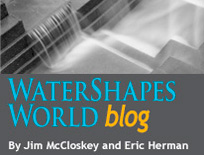
Eric Herman
 It’s a given: As human beings, we are all utterly dependent on the availability of fresh, clear, potable water for our survival. As a result, the preservation of aquatic resources of all types is an interest in which all people should share. At the same time, however, the supply of potable water is so reliable in our society that most people scarcely give it a thought beyond being annoyed by growing water bills.
It’s a given: As human beings, we are all utterly dependent on the availability of fresh, clear, potable water for our survival. As a result, the preservation of aquatic resources of all types is an interest in which all people should share. At the same time, however, the supply of potable water is so reliable in our society that most people scarcely give it a thought beyond being annoyed by growing water bills.
I bring this up because seemingly everywhere I turn these days I run into stories about contaminated runoff, pollution of groundwater resources and various threats to key aquifers and water supplies. As one of the better-informed human beings about these issues, I find myself wondering at times whether the future of watershaping might even be at stake – and if we or our kids might face a time when the very availability of potable water will be at risk.
This is why I’ve long felt that, as professionals working in an industry focused on the enjoyment and creative use of a portion of the world’s potable water, we have a sublime need to focus on this basic resource and a collective responsibility to do all we can to protect, defend and extend it.
On April 27, my curiosity was engaged when the federal government released “Clean Water: Foundation of Healthy Communities and a Healthy Environment.” In a nutshell, this 19-page document outlines a set of national objectives aimed at ensuring the future of our waterways, public water supplies and overall water resources.
The document mainly represents a philosophical updating of the Clean Water Act of 1972 and contains what seem to me to be sensible extensions of that 40-year-old mandate by including specific discussions of sustainability, the need for restoration of urban water systems and the development of incentives to encourage water conservation in agricultural and industrial settings.
I was particularly interested to note that the new framework specifically endorses restoration and better management of a range of iconic waterways, including Chesapeake Bay, the river deltas feeding San Francisco Bay, the Great Lakes, the Everglades and even the immensity of the Gulf of Mexico.
The framework calls more generally on policymakers, consumers, farmers and business operators to protect their interests by saving water (and therefore money) through pursuit of 21st century approaches to water technology and management.
In general, I personally like the idea of preserving and enhancing access to aquatic environments. It also makes sense to me to call on both the government and the private sector to work together to preserve our water resources. In reading this government document, it becomes clear that the framework is not about starry-eyed environmentalism, but rather is aimed at helping us make smarter decisions regarding the management of this crucial resource.












